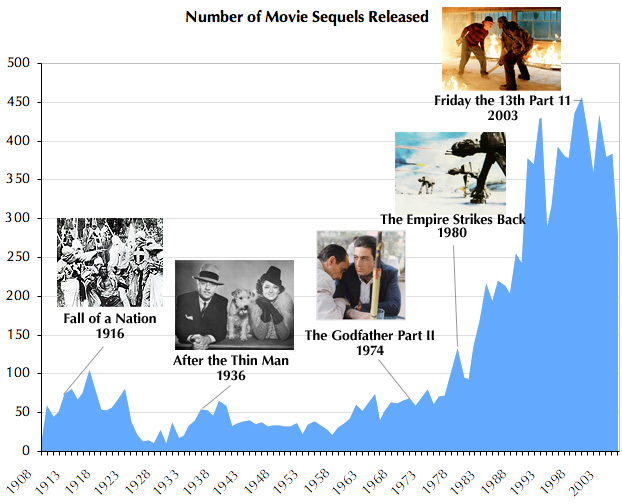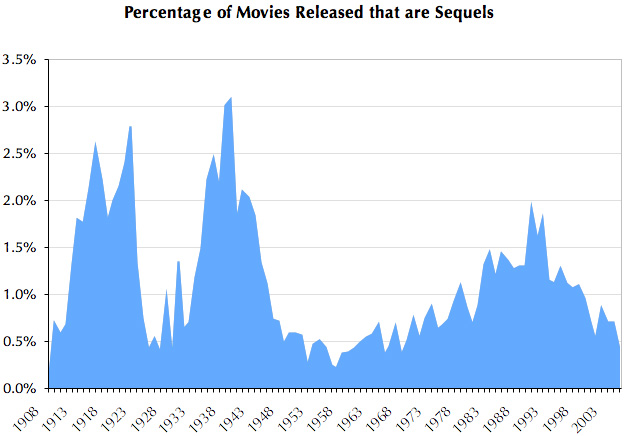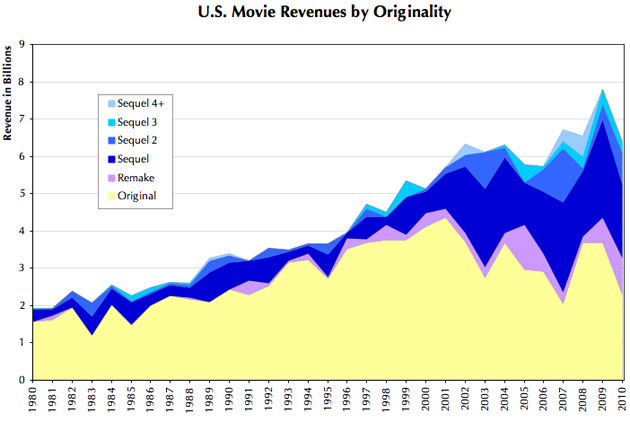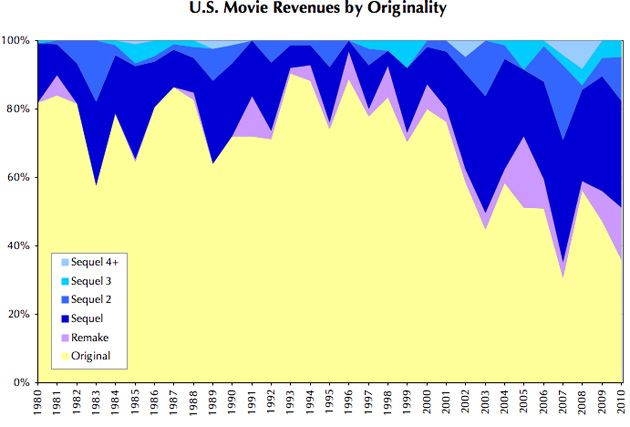The Creeping Ubiquity of Movie Sequels
7 Dec 2010
The sequel has been around forever. It’s natural for an audience to want the stories they like to continue. When storytelling became marketable through print in the 18th century, sequels became a reliable stream of income. When movies emerged a century ago, the sequel seemed like a logical fit, both as a storytelling device and as a money-maker.
So how many movies made are actually sequels? Here’s my raw estimate:

Here’s how that compares to the number of all movies:

Sequel-making is on the rise, but it’s not keeping up with overall movie releases. The cost of production is dropping, so new movies are being released all the time. More and more aren’t sequels. Yet — people are watching sequels more than ever.
Originality in 1984
In 1984, original screenplays dominated the box office. Even Indiana Jones and the Temple of Doom and Star Trek III were based on original screenplays despite being sequels. These are stories that aren’t based on anything except the imagination of the screenwriters’ and producers’ imagination. Not books, not comics, not video games, not old TV shows (except Star Trek). The top 10 isn’t an anomaly either. Other hugely successful originals in the top 25 included Purple Rain, Amadeus, Tightrope, Revenge of the Nerds, Breakin’, Bachelor Party, Red Dawn, the Terminator, the Killing Fields, and Places in the Heart (among others). |
    
|
|||||||||||||||||||||||||||||||||
Originality in 2007
Fast forward 23 years. Not a single movie in the top 10 is based on an original idea. Every one is the continuation of a movie franchise, or an adaptation of a book, an amusement park ride, or a reboot of a TV show. |
   
|
|||||||||||||||||||||||||||||||||
Looking at Sequel Money for All Years
For lots of reasons — built-in audience, existing marketing streams — sequels make more money than non-sequels. Even if they take up a smaller percentage of overall movies made, they’re a much safer financial bet for studios than original movies.
The shift between 1984 and 2007 is dramatic, but is it a continuing trend? To see exactly how often these studios are going the “safe” route, I looked at revenue for the top 50 grossing (domestic) movies of each year since 1980. (The top 50 seemed like a good cut-off since 65% of 2010′s movie revenue has come from the top 50 movies. That number has been as high as 80% in recent years).
The Process – Instead of manually tabulating what movies are sequels and what aren’t (that would take forever), I set up semantic structures based loosely on IMDb‘s and Wikipedia‘s movie pages, then analyzed a combination of keywords, similar web links, and related metatags (Wikipedia, for instance, allows entries to have a “next” or “previous” in the series). A spot-check revealed a very accurate categorization — even with the subtleties — although I’m sure it’s not perfect. An example: Batman Forever was categorized a sequel, but Batman Begins a remake.
Broken down by percentage:
For another time: the yellow original section in the last five years is more than 70% book, comic, TV, and video game adaptations.
What’s Wrong with the Creep?
Sequels are profitable. Embracing this new incrementalism makes sense for studios, and you can’t fault them for sticking with what works. The ubiquity of this logic was even the basis for the satire of Hamlet 2.
There are more movies than ever to see. So what’s the problem? If I want to want some schlocky big-budget sequel, I should be able to do so without derision, right? There’s nothing wrong with going to see whatever I want!
Wrong. The internet is making it easier to stream obscure movies that weren’t available a few years ago. But there are only a limited number of full-sized theaters. The movie-going experience is something unique that hasn’t been fully replicated at home yet. Until it is, the movies that make money will flood the theaters first, and it will be more and more difficult for you to find original movies to see on the big screen and be seen in their intended original art form. Will there ultimately be a backlash and shift? Not until the market dictates it. And you can bet that Disney will continue to pump out hundreds of millions in marketing to guarantee their expensive investments like Pirates of the Caribbean are seen before anything else. Some say that sequels can be original but I think they’re recognized with a lot of awards because there’s a lack of mainstream alternatives.
One scary scenario: studios start behaving like pharmaceutical giants. 10-15 years ago, Big Pharma started making super profits from its blockbusters in a very similar way to movies do today. Pharma in one of the most profitable industries in the U.S. has spawned two trends: more money is being spent on marketing than R&D and government lobbying is growing like crazy. (I’d argue that, although government involvement is to blame for some of this; it’s a result of lobbying and not proactive anti-trust measures).
Liken Pharma R&D to movie originality, and lobbying to media promotion and studio PR. If in 10 years, the movie industry mirrored the pharmaceutical industry of today, we’ll all be slaves to monster sequels and 3D eye-rapings.
The size of home TVs and entertainment systems is going up and the cost is going down (whether that’s a good thing is worth another post). So at least the original stuff will find an audience eventually, even if it’s not on a 50 foot screen. Social media could play a role in helping indie gems bubble up to popularity. I personally think the most likely catalysts to derail the sequel gravy train are activist studios with less financial focus like Participant Productions.
But until then, there are unofficially 86 big budget movie sequels in production and no end in sight.
At least there’s a good chance I’ll get to see There Will Be Blood 2: The Legend of H.W.’s Black Gold.
























